Use 'Print preview' to check the number of pages and printer settings.
Print functionality varies between browsers.
Printable page generated Thursday, 27 November 2025, 4:21 AM
Study Session 4 The Water Cycle and Sources of Water
Introduction
Water is a valuable natural resource that is found in different forms in the environment. It is important to understand how water moves through the environment so that we can understand how to manage it successfully. Fresh water is finite and vulnerable. Supplying sufficient clean, fresh water is one of the most vital natural resource issues facing humanity. Water shortages are becoming a global issue, due to an increasing population, economic growth and climate change. A lack of clean, fresh water can hinder the efforts to reduce poverty and progress national development, resulting in poor health, low productivity, food insecurity and restricted economic development.
In this study session you will learn about the hydrological cycle. You will learn about where fresh water is found, the types of water sources that people use and how important it is to select suitable water sources. Finally, you will look at the increasing demands on supplies of fresh water.
Learning Outcomes for Study Session 4
When you have studied this session, you should be able to:
4.1 Define and use correctly all of the key words printed in bold. (SAQ 4.1)
4.2 Describe the hydrological cycle. (SAQ 4.1)
4.3 Describe the main types of water source. (SAQ 4.2)
4.4 Outline the main factors to be considered when selecting a water source. (SAQ 4.3)
4.5 Describe the factors affecting the distribution and availability of water resources. (SAQs 4.2 and 4.4)
4.1 The hydrological or water cycle
Water is continually moving around the Earth and continuously changing its physical form.
In which three forms can water be found on Earth?
Water can be found in liquid form in oceans, rivers, lakes and rain; in solid form in ice and snow; and as a gas (water vapour) in the atmosphere.
The hydrological cycle, or water cycle, is the continuous circulation of water between oceans, atmosphere and land (Figure 4.1). The sun and wind cause water to evaporate (change its physical state from liquid to gas) from land and water bodies (oceans, lakes and rivers). Also, plants take up liquid water and give off water vapour through pores in their leaves in a process called transpiration. The water vapour moves high above the Earth’s surface on rising currents of air through the atmosphere. Eventually as the water vapour reaches the cooler air higher up in the atmosphere, it condenses (changing from gas to liquid) to form clouds and falls back to Earth in the form of rain and snow (together these are called precipitation). Precipitation that falls on land can flow over the surface as run-off into rivers and streams, and can also percolate (trickle down) through the soil into underground rocks to become groundwater.
Water is held in reservoirs (indicated in Figure 4.1) and moves between them in transfer processes. (‘Reservoirs’ here refers to all stores or reserves of water, not just water held behind a dam.) The water transfer processes continue in an ongoing cycle through evaporation and transpiration, transportation of water vapour in the atmosphere, precipitation, and water flowing off and through the land back to the sea.
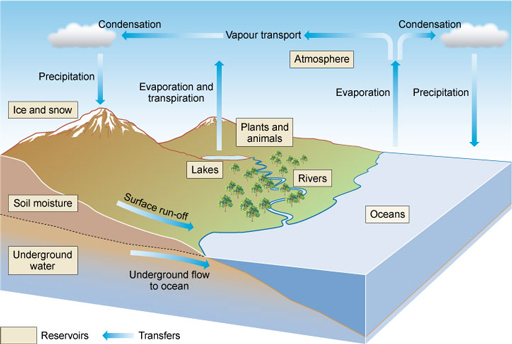
Why is water described as a renewable resource?
Because the processes of the water cycle are constantly renewing the surface water and groundwater. Precipitation (rainfall) feeds the rivers and streams and infiltrates into the ground to replace the water that we use.
4.2 Distribution of water resources
About two-thirds of the Earth’s surface is covered with water. The total amount of water on the Earth is about 1400 million km3 (UNEP, 2002). Of this, around 97.5% by volume is held in the oceans and is salt water. Only 2.5% (or about 35 million km3) is fresh water. Figure 4.2 shows the proportions of Earth’s water found in different parts of the environment.
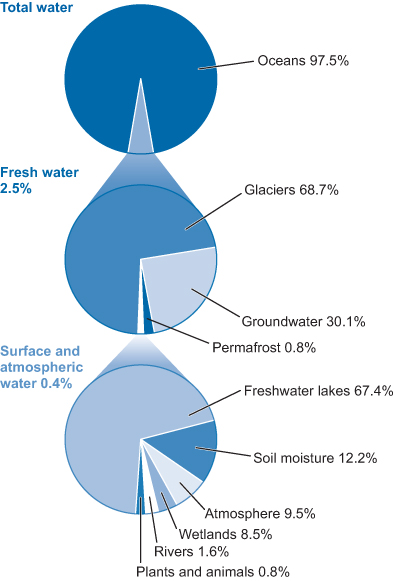
From Figure 4.2, which percentages of fresh water are estimated to be stored in the forms of: ice and permanent snow (glaciers), groundwater, and as surface and atmospheric water?
Around 69% is stored in the form of ice and permanent snow, about 30% as groundwater,and only about 0.4% of fresh water is stored as surface and atmospheric water.
Fresh water is water with a dissolved salt concentration of less than 1%. Globally, fresh water is distributed unevenly. About three-quarters of global annual rainfall occurs in countries containing less than one-third of the world’s population. About 80% of the world’s water run-off is concentrated in countries in northern and equatorial regions, which have relatively small populations. For example, the Amazon River in South America accounts for 20% of global run-off each year. The area drained by the Amazon is huge, but it is sparsely populated. In Africa, the Congo River and its tributaries account for 30% of the entire continent’s annual run-off, but the Congo’s area contains only 10% of Africa’s population.
Why is it a problem that the huge areas of the Amazon and Congo rivers have large amounts of fresh water but only a relatively small number of people?
The problem is that the fresh water is unequally distributed. A large proportion is found in places that are remote from the majority of the population so the water is not available to them.
An additional problem is that rainfall throughout much of the developing world is highly seasonal. The seasonal rains may last for only between one and three months, which can leave people short of fresh water during the dry season.
4.2.1 Distribution of fresh water in Ethiopia
In Ethiopia, there are 12 major river basins/valleys, 11 lakes, 9 saline lakes, 4 crater lakes and more than 12 major swamps (Mekiso, n.d.). The average annual flow of water from all the 12 river basins is estimated to be 123.25 billion m3 (Figure 4.3). Several of the major rivers cross to neighbouring countries. For example, the Abbay River flows to Sudan and Egypt, and the Omo to Kenya. It has been estimated that 95% of Ethiopia’s annual run-off flows out of the country in these cross-boundary rivers (Waterwiki, n.d.).
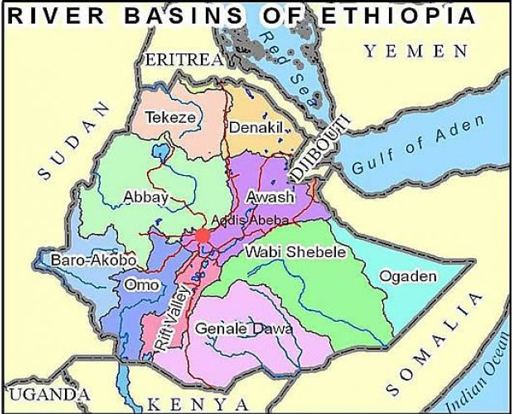
In Ethiopia, it is estimated that 54.4 billion m3 of surface run-off and 2.6 billion m3 of groundwater could be developed for use by people. However, the amount of rainfall, river flow and groundwater is highly variable across the country and depends on location and altitude. Some areas have sufficient water, while others don’t have enough. Figure 4.4 shows maps of rainfall and groundwater availability during drought in Ethiopia. Most permanent springs and streams exist only in the highlands in the west of the country. In areas below 1500 m above sea level, which is more than 55% of the country, there is hardly any surface run-off and very few permanent springs and streams.
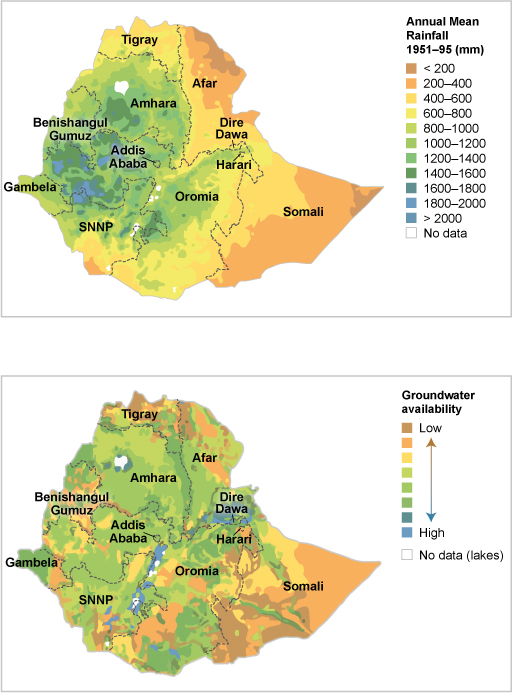
Based on the two maps in Figure 4.4, which regions of Ethiopia have the least available water?
Somali and Afar regions have the lowest mean annual rainfall in the country. Somali also has very little available groundwater. Afar has relatively high groundwater availability.
The availability of water resources is also uneven over the year. At some times of the year you might have too much water, leading to flooding. At other times there may not be enough water, leading to drought.
4.3 Sources of water
Our main sources of water for drinking, washing, agriculture and industry are surface water, groundwater and collected rainwater, all of which are dependent on rain and snow falling on the Earth’s surface.
4.3.1 Surface water
Rivers, streams, lakes, and ponds are widely used as water sources in Ethiopia, especially in rural areas (Figure 4.5). The amount of available surface water depends largely on rainfall. When rainfall is limited, the supply of surface water will vary considerably between wet and dry seasons and also between years. One way to overcome this problem is to construct a dam across a river to create a reservoir that provides water storage. Large surface water reservoirs may be used for hydroelectric power generation, regulating water releases to control river flows, for recreational purposes and to provide water for agricultural, municipal and industrial uses. Smaller dams are also used to enable irrigation (Figure 4.6). The water collects behind the dam and flows under gravity into irrigation channels leading to the fields.

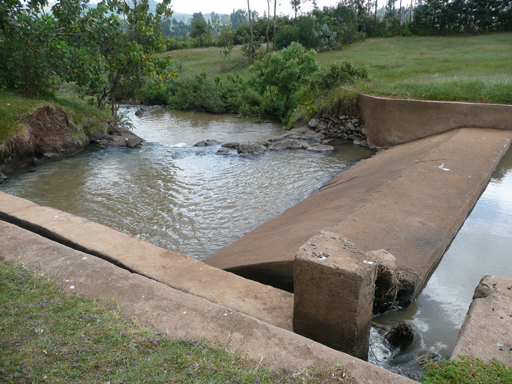
4.3.2 Groundwater
An aquifer is an underground layer of water-bearing rock.Water-bearing rocks are permeable, meaning that liquids and gases can pass through them. Groundwater is the water contained in aquifers (Figure 4.7). This is replenished or recharged by precipitation that percolates through the soil to the water table, and by water seeping from streams, as well as other bodies of surface water, such as lakes and wetlands.
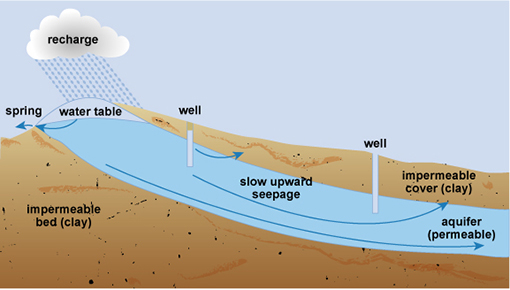
The water table is the top of the groundwater below the land surface. Its level fluctuates seasonally and from year to year as the inputs from precipitation and the outputs vary. The depth of the water table also varies with location, from being near to the land surface in areas close to surface water bodies and in humid climates, to being hundreds of metres below the land surface in drier regions.
Groundwater reaches the surface naturally through springs or artificially through wells. Springs typically rise up where the water table meets the land surface. Springs are important sources of water to feed streams and are attractive cultural and landscape features in themselves. Wells and boreholes are dug by hand or drilled by machine. These have to be deep enough to extend below the water table so that water can be drawn up by bucket or by pumping.
4.3.3 Rainwater
Rainwater is also an important source of water, although on a relatively small scale. Collecting rain from roofs or other hard-surfaced areas and storing it until it is needed can provide a valuable source of water for many purposes.
4.4 Water source selection
The quantity, quality, and reliability of available water are three main factors that need to be considered when evaluating water sources. Socio-cultural and technical issues may also be important. This section provides an overview of some of these different factors.
4.4.1 Water quantity
If you were selecting a new source of water for a community you would need to be sure that the volume of water that could be supplied would be sufficient to meet the community’s needs, both now and in the future. It would also be important to consider the reliability of the source over time.
4.4.2 Water quality
The quality of water required depends on what it will be used for. Drinking water must be clean and safe to drink and protected from any contamination by pathogens or other pollutants. The primary concern must be to prevent the transmission of waterborne diseases. For other water uses such as for domestic washing or for agricultural or industrial uses, the quality is less critical.
In general, surface water sources are likely to contain many different materials and potential pollutants. These include micro-organisms, some of which may be pathogens, and small solid particles referred to as suspended particulates or suspended solids. These make the water turbid (Figure 4.8). Turbidity (the cloudiness of water) is a measure of water clarity. Turbidity is considered a useful approximate measure of water quality because pollutants and micro-organisms can be carried on the surface of suspended solids. The more turbid or cloudy the water is, the more suspended particles there are in it, and the more polluted the water is likely to be. It is important to realise, however, that clear water is not necessarily clean, because some contaminants may not be visible.
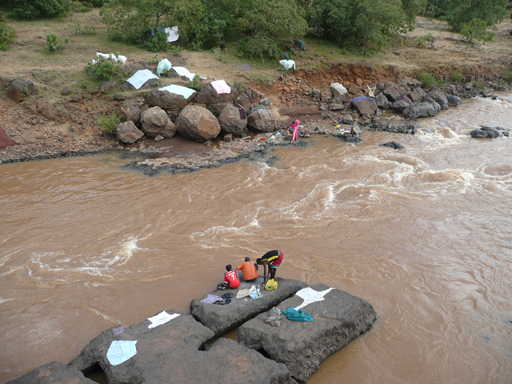
Why is surface water likely to be turbid?
Surface water is highly vulnerable to turbidity because solid particles of soil are washed off the land in run-off that flows to river and lakes, especially by heavy rains.
Surface water is easily polluted and can be affected by wide seasonal variations in turbidity. As a water source, surface water is often the easiest to access, but large quantities of suspended solids make it difficult to treat effectively. In general, groundwater is less likely than surface water to be polluted by pathogens or solid particles because the water is cleaned to some extent as it percolates down into the rock. However, it may have higher concentrations of dissolved substances. This means that groundwater has less microbial contamination but the dissolved substances and minerals, such as fluoride, may have significant effects on its quality.
Fluoride
Fluoride in drinking water is a well-known health concern. In some parts of Ethiopia concentrations in groundwater exceed the World Health Organization guideline of 1.5 mg/l (milligrams per litre). The highest concentrations, which can be greater than 10 mg/l, are found in waters from the Rift Valley zone. For people living in this area, dental and skeletal fluorosis are significant public health problems causing brown patches on the teeth, joint pain, limited movement of joints and, ultimately, crippling.
The National Fluorosis Mitigation Project has responsibility for planning a national strategy to deal with this problem. Several methods of defluoridation (removing fluoride from water) using chemicals or bone char have been successfully trialled at community and household levels (Osterwalder et al., 2015; Abaire et al., 2009; Esayas et al., 2009). However, selecting an affordable and sustainable standard technology for widespread use is challenging. Yang et al. (2015) found there is no single, preferable method for fluoride removal in Ethiopia because selection depends on the specific conditions of each location and on the preferences of the people involved.
4.4.3 Socio-cultural considerations
Socio-cultural considerations may be important for water source development. Before a new water source is developed, a thorough assessment of the needs and wishes of the community should be undertaken, involving all groups of people including women, men, and children, members of any distinct social groups, disabled persons, and other vulnerable groups. It is particularly important that women participate in the process because they are likely to have the most knowledge about existing sources and are most likely to benefit if new supplies are developed. If the community’s opinions are not taken into account, the water supply system is likely to be under-used and may easily fall into disrepair, causing people to revert to their old water sources which may be more polluted.
Case Study 4.1 Hadera and the community who would not drink the blood of their forefathers
Hadera is a senior WASH expert working as a water and sanitation coordinator in small rural town. The town’s inhabitants had been suffering from a critical lack of sufficient safe water supplies and from waterborne diseases. Hadera had a good connection with the manager of an international non-governmental organisation (INGO), and convinced him to develop a water supply scheme for the needy community. The INGO finally managed to dig a well and get a good yield of water, and was able to handover the new facility to the kebele leadership for community use. Unfortunately, the community refused to use the water supply as their drinking water source. The INGO was surprised and asked them why not, mentioning the huge investment put into developing the water point in order to support the community. The community replied ‘we will not drink the blood of our forefathers’. The water source was developed in an area that served as a burial place many years ago and the villagers believed that the water contained the blood of their ancestors and so would not drink it.
What should Hadera and the INGO have done differently?
The problem could have been avoided if the villagers had been involved and consulted in the process of the water source development.
4.4.4 Technical requirements
The development of the source must be technically feasible and the operation and maintenance requirements for the source abstraction and supply system must be appropriate to the resources available. Supply systems are likely to be misused if they cannot be operated and maintained either by community members or by organisations and institutions within the area.People who have responsibility for the maintenance of water sources or distribution points should be properly trained and rewarded for their contribution, to ensure sustainability.
4.5 Depletion and contamination of water sources
As you read in Study Session 1, humans interact with water both by using it and by producing the wastes that may contaminate it. Both of these activities can damage water sources.
4.5.1 Water source depletion
Although water is a renewable resource, excessive extraction of water will result in its depletion. If groundwater is extracted from aquifers more quickly than the water is replenished by recharging, this will lower the water table. Excessive groundwater pumping changes the flow patterns around wells and creates a localised depletion of groundwater stores in the area around the well. If several wells are located close together these zones can overlap. The result is that existing wells and boreholes may dry up and new ones have to be dug deeper and deeper before they reach water. The lowering of the water table also affects rivers and streams, which are normally fed partially by underground water. Over-exploitation of groundwater can also affect springs, which may change from permanent to temporary or even dry up completely.
Water source depletion is also directly linked to reduction in forest cover. With the loss of trees and other vegetation, rainwater runs straight off the surface and does not penetrate into the ground to recharge the groundwater. Added to this are the uncertainty of climate change and the effects of periods of drought which have a serious impact on the availability of surface and groundwater sources.
4.5.2 Water source contamination
Surface water can become contaminated in many ways. This may by direct discharge into the river from a sewer or pipe. Rivers and streams are considered to be convenient ways of disposing of wastewaters of all types, including domestic and industrial wastes. Industrial sources may discharge hazardous substances, as well as organic matter and suspended solids without adequate treatment. Surface water pollution can also come from stormwater run-off, which may carry contaminated materials into the water. Open defecation and the uncontrolled disposal of solid wastes are two likely sources of contamination by run-off.
Groundwater is generally cleaner than surface water for reasons explained earlier but pollution of groundwater resources has become a major problem in Ethiopia and around the world. Groundwater is polluted by the leaching of human and industrial waste, pesticides and fertilisers, which infiltrate into the aquifers from the surface and pollute groundwater supplies. Pit latrines that are located too close to a water source or are poorly constructed and maintained can also be sources of groundwater contamination. The polluted water reaches people and animals through contaminated spring and well water.
4.6 Water demand and supply
You will recall from Study Session 1 that many countries in the world, including Ethiopia, are suffering from water stress or water scarcity. The world is heading towards a fresh water crisis, partly due to mismanagement and partly due to the unequal distribution and small amount of fresh water available in the first place. This crisis is already evident in many parts of the world, varying in scale and intensity depending on the time of the year, climate and location.
The imbalance between the demand for and the supply of water is increasing globally. On the one hand, the volume available for supply remains much the same but has additional problems of contamination of surface and groundwater sources, inefficient utilisation of available supplies and the uncertainties of climate change. On the other hand, the demand for fresh water per capita is rising as countries develop economically. Industrial development leads to additional demands for water and, at the same time, agriculture is becoming increasingly dependent on irrigation to produce food for the growing population.
The global challenge is to find ways to manage the increasing demand for water but this is not to say that everyone should use less water. Developing countries still use far less water per capita than developed regions. Household use in developing countries is especially low, reflecting the difficulty many people have in obtaining clean water for personal use. Improving access to water is important so that people can use more water for household and personal hygiene, which will improve living standards and bring significant benefits to health and well-being.
Population growth, urbanisation and migration all affect the availability and quality of water resources. With the rapid increase in urbanisation, meeting the demand for fresh water will be difficult for cities. Rapid urban growth in developing countries puts tremendous pressure on inadequate water supply systems and can lead to water shortages. The next two study sessions look more closely at urbanisation and its causes and effects.
Summary of Study Session 4
In Study Session 4, you have learned that:
- Water is continually moving around the Earth and continuously changing its form. The hydrological cycle maintains a balance between evaporation, precipitation, the transport of water vapour in the atmosphere from the sea to the land and run-off from land to sea.
- About two-thirds of the Earth's surface is covered with water. Of this, around 97.5% by volume is held in the oceans as salt water; only 2.5% is fresh water and only a very small fraction of this is accessible as a water source.
- Surface water, groundwater and rainwater are our main sources of water. The quantity, quality, and reliability of available water are the important factors considered when sourcing water.
- Fluorosis caused by fluoride in water is a well-known health problem in Ethiopia. The highest concentrations of fluoride are found in waters from the Rift Valley zone.
- Selecting a water source for a community supply system requires careful consideration of a range of factors, such aswater quantity and quality, technical requirements and socio-cultural considerations.
- Water sources can be depleted by over-extraction and can be contaminated by pollutants.
- Globally, the consumption of water is increasing due to the rising population and increased consumption per capita. Water use per capita in developing countries is far less than in industrialised countries.
Self-Assessment Questions (SAQs) for Study Session 4
Now that you have completed this study session, you can assess how well you have achieved its Learning Outcomes by answering these questions.
SAQ 4.1 (tests Learning Outcomes 4.1 and 4.2)
Rewrite the paragraph below using terms from the list provided to fill the gaps.
aquifers, condenses, evaporation, groundwater, hydrological, percolates, precipitation, run-off, transpiration.
Water on the Earth’s surface moves in an unceasing cycle through rivers, oceans, clouds and rain called the water or ……………… cycle. The heat from the sun causes ……………… of water from oceans and from lakes and wetlands on land. Plants lose water through their leaves by ……………… Water vapour in the atmosphere ……………… to form clouds which are moved around by wind. Rain and snow, collectively known as ………………, fall from the clouds. Some water that falls on the ground forms ……………… which collects into streams and rivers and some ……………… through the soil to become ………………, which is held in layers of rock called ………………
Answer
Water on the Earth’s surface moves in an unceasing cycle through rivers, oceans, clouds and rain called the water or hydrological cycle. The heat from the sun causes evaporation of water from oceans and from lakes and wetlands on land. Plants lose water through their leaves by transpiration. Water vapour in the atmosphere condenses to form clouds which are moved around by wind. Rain and snow, collectively known as precipitation, fall from the clouds. Some water that falls on the ground forms run-off which collects into streams and rivers and some percolates through the soil to become groundwater, which is held in layers of rock called aquifers.
SAQ 4.2 (tests Learning Outcomes 4.3 and 4.5)
Name the three main types of water source that people use and explain how each would be affected by an extended period of drought.
Answer
The main sources of water are surface water, groundwater and rainwater. Rainwater collection is obviously not possible during times of drought. The water available from surface water sources such as rivers and lakes will be reduced by drought because there will be no run-off so the volume of water in rivers and lakes will fall and they may even dry up. Groundwater reserves will also be reduced by drought although not as immediately as surface water. If there is no rainfall to recharge the aquifer and water continues to be extracted then the water table will gradually drop.
SAQ 4.3 (tests Learning Outcome 4.4)
Town A has does not have a convenient water source for its residents. You are part of a team that has been tasked to select a water source for development to meet the water needs of Town A. List four points that you need to consider as part of the selection process.
Answer
You might have considered the following four points:
- Water quantity and reliability; there must be sufficient quantity of water to meet current and future needs.
- Water quality; the water must be free from contamination; fluoride levels may be relevant in some locations.
- Socio-cultural considerations; there may be local beliefs and practices among users that should be considered.
- Technical requirements; the practical feasibility of developing the source is important; operation and maintenance in the future should also be planned.
SAQ 4.4 (tests Learning Outcome 4.5)
Which of the following statements are false? In each case explain why it is incorrect.
- A.More fresh water is held in lakes on the Earth’s surface than is held in aquifers as groundwater.
- B.Demand for water tends to increase as countries develop economically.
- C.In rainy seasons, surface water sources are topped up with fresh water therefore they are less likely to be contaminated with pathogenic micro-organisms than groundwater sources.
- D.Ethiopia has plentiful supplies of fresh water but it is not evenly distributed across the country.
- E.Globally, the demand for water is increasing but the volume available to meet that demand is not.
Answer
A is false. From Figure 4.2 approximately 30% of fresh water is groundwater and only 0.4% is surface and atmospheric water. The volume of water held in lakes is approximately two-thirds (67.4%) of this 0.4%, and therefore there is much more water in aquifers than in lakes.
C is false. Rainwater will wash all types of contaminants including pathogenic micro-organisms into rivers and lakes, so they are more likely to be polluted than groundwater. It is possible for groundwater to be contaminated but if pathogens are present, most are removed as the water trickles down through soil and rock.